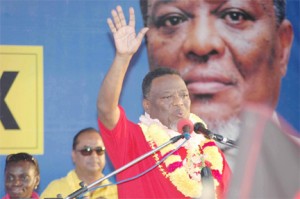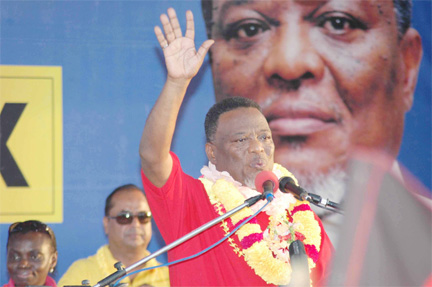The formation of the People’s Progressive Party-Civic alliance was a useful political expedient in 1992. The creation of the Civic Group fostered the notion that the majority party could abandon the winner-take-all style of politics which could lead to authoritarianism. It also reassured some elements of civil society that such a group could provide an institution through which its interests could be represented. Has the alliance fulfilled these lofty expectations?

Prime Minister Samuel Hinds is the only man left standing from the original Civic Group now that former Minister of Foreign Trade and International Cooperation Dr Henry Jeffrey has resigned from the cabinet. Although the People’s Progressive Party-Civic retained the name, the meaning of ‘civic’ has changed and its mission, never quite accomplished, has expired. Persons once identified as members of the Civic Group have left the political scene without being replaced. This has altered the balance between the party and the group and diminished the role that the latter was expected to play.
Idea
The Civic Group was formed nearly 18 years ago from among individual persons who were invited by the People’s Progressive Party to collaborate in its quest for victory in the 1992 general elections. Amorphous in form, the Group has played an ambiguous role in party politics. It seems never to have had a stable membership, an organisational structure, a body of common rules or even shared beliefs and objectives. To the extent that a political alliance is usually an agreement among established entities, the Civic Group was never more than a motley collection of citizens whose main qualification for office was their personal acceptance of the PPP’s offer to them to serve. According to Henry Jeffrey:
The Civic idea was to place, within the policy-making forum of the PPP, a group of people who by their ideology, individuality and general collectivity could eliminate some of the shortcomings the party was thought to have. The members of this group were to be people who would, inter alia, be nationalist, support private enterprise, physically and intellectually provide a vision of a non-racial Guyana and fill such leadership gaps as were thought to exist.
It has never been explained how the abilities and other attributes of individuals identified to become members of the Group could be determined and what objective criteria were used in their selection. Vague values such as ideology, intellect, nationalism and racism are notoriously difficult to measure and, in the last analysis, evaluation and selection were likely to be subjective.
The idea of an alliance between organised political parties and unorganised elements of civil society had its origin in the resistance to a series of manipulated general elections by the People’s National Congress administration between December 1968 and December 1985. At last, five parties which contested the 1985 elections − the Democratic Labour Movement; National Democratic Front; People’s Democratic Movement; People’s Progressive Party; and the Working People’s Alliance − formed a coalition called the Patriotic Coalition for Democracy which aimed primarily at the struggle to restore free and fair elections to the country.
Illusion
Hopes that the coalition could transform itself into an electoral front – with a consensus presidential candidate and a joint slate of candidates for the National Assembly – proved illusory and its efforts foundered from the start. Discussions were dogged by mutual suspicion, more about personalities than policies. Even with the onset of the next general elections that were expected in 1990, agreement could not be reached on the essential issues.
At that stage, a new group of concerned citizens – calling itself the Democratic Reform Movement and comprising business persons, professionals and trade unionists – was formed with the similar aim of supporting the struggle for free and fair elections. This movement attracted adherents from civil society and later adopted the name Guyanese Action for Reform and Democracy. It emphasised that it would remain independent of political parties while setting itself the task of encouraging popular participation in the electoral process.
GUARD, at first, attracted the membership of several prominent citizens including Basil Butcher, a former test cricketer; Randolph George, Bishop of the Anglican Diocese; Nanda Gopaul, a trade unionist; Samuel Hinds, a chemical engineer; Clairmont Lye, a businessman; Michael McCormack, a human rights activist; Andrew Morrison, a priest of the Roman Catholic Church; and Albert Rodrigues, an architect, among others. GUARD’s aim was to remain purely a civic movement. At its first public rally on 19 June 1990 in Georgetown, it drew a large crowd – the envy of the established political parties – and urged attendees to demand free and fair elections.
Certain elements, however, started to nudge the movement in the direction of political involvement. From July 1990, those persons precociously proposed the formation of an interim administration, drafting of a new constitution and the nomination of persons to serve in government. By October 1990, the movement was thrown into disarray when Ashton Chase, a former PPP minister and senator, was named as a possible presidential candidate.
Owing to widespread dissatisfaction over the Guyana Elections Commission’s compilation of the Preliminary Voters’ List, the elections scheduled for December 1990 were postponed. The unexpected delay provided an opportunity for the reconfiguration of the campaign for electoral reform and the realignment of political forces. Shortly afterwards, GUARD’s efforts were completely undermined when the PPP approached Samuel Hinds, the movement’s chairman, to accept the position as Prime Ministerial candidate, and convinced other members to join him on the PPP ticket. Predictably, as a result, this manoeuvre fractured the movement. Several persons decided to go political by openly allying themselves with the PPP and others attempting to preserve the integrity of the movement by adhering to its original mission of neutrality. They failed.
With the death of both the PCD and GUARD, the birth of the Civic Group was announced. The PPP then declared in November 1990 that, with its ‘winner-does-not-take-all policy,’ it was still committed to form a post-election, broad-based, multi-party, multi-racial, multi-class and multi-ideology administration if the PPP-Civic slate should win the general elections. The PPP-Civic alliance was eventually formally approved by the PPP’s 24th congress held in August 1991.
After the destruction of the original GUARD, Nanda Gopaul led a faction to do exactly what the movement had pledged not to do, that is, to contest the elections. A new party, the Guyana Labour Party, sprouted from GUARD’s debris, holding its first meeting on 19 August 1992. But, as elections drew closer, its supporters were baldly advised to support PPP. The rest is history.
Image
The PPP-Civic Alliance emerged as the majority at the 5th October 1992 elections. At the start, six members of the Civic Group − Dale Bisnauth; Bernard de Santos; Vibert de Souza; Samuel Hinds; George Fung-On; and Henry Jeffrey − were appointed ministers in Dr Cheddi Jagan’s first post-elections administration. It was claimed that there were about two dozen other such persons in the Group at that time who did not hold public office. Cheddi Jagan asserted that the alliance effectively institutionalised national unity:
The PPP-Civic alliance represents all classes and strata in the Guyanese society, and its victory has instituted a government of national unity. It provides for racial-ethnic and class balance and ideological pluralism in a national-democratic state.
With thirty-seven per cent of the original cabinet of sixteen members, the Civic Group seemed to be quite strong but its influence was always illusory. The Group did create the image of diversity, contributing African, Amerindian, Chinese and Portuguese ministers. But, image apart, the individuals did not bring an articulated agenda to bear on the PPP’s political programme. This, normally an important aspect of any alliance, might have been a missed opportunity. A more effective leader might have insisted on expanding the group and extending its influence.
At the outset, some attempt was made to consult the group and treat it respectfully as a junior partner. According to Henry Jeffrey:
The Civic does not have a separate forum but meets once a month or as is necessary, in combination with the leadership of the PPP. There is normally a formal agenda which can include all aspects of governance – ministerial reports, questions on matters of major importance, motions to investigate any issue of national life, etc. The President and Prime Minister are present at all Civic meetings. The Civic, then, is not a static handful of people, but a growing institution with major access to power.
The momentum was not maintained and cabinet reshuffles gradually eroded the Group’s position in the administration. How did the Civic Group die? It is evident that the PPP never intended to fulfil its pre-election promise to share power with the other opposition parties. From the start, the Civic Group was a creature of the PPP. It was not as an independent partner but an arm of the party without any agreed rights, obligations or privileges. In enabled the PPP to claim, as it did, that the ‘winner-did-not-take-all.’
Institution
In short, the Civic Group has never fulfilled the promise for which the PPP created it. On the institutional side, as the years went by and the PPP became increasingly confident that it could win clear majorities without the pretense of alliances, civic members disappeared and no attempt was made to replace them. On the ideological side, the Group did introduce persons of differing ideological persuasions but there is no evidence that they made serious inputs into policy-making. On the political side, the Group has never marshalled its supporters into a voting constituency and seems never to have contributed to augmenting the PPP’s electoral tally. On the ethnic side, the Group did add some colour that enabled the PPP to demonstrate that it was prepared to accommodate ministers of all the races in Guyana. That is now at an end, however, as the last ministers of Chinese and Portuguese descent have disappeared.
The legend of the Civic alliance has been an important lesson in realpolitik. In the end, it showed the futility of idealistic but inept efforts in attempting to alter the behaviour of an obdurate and experienced political party.

